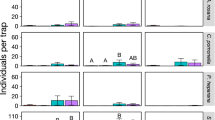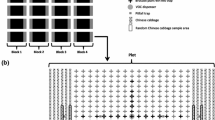Abstract
Considerable basic information has been gathered on the interaction between the onion fly (Delia antiqua) and its host plant, the onion (Allium cepa). An attempt is underway to manipulate ovipositional behavior of this pest by treating onion seedlings with chemical deterrents while simultaneously providing deeply planted onion culls on which onion flies prefer to lay. This bipolar strategy of behavioral manipulation, termed “stimulo-deterrent diversion” (SDD), has the advantages of: (1) avoiding severe pest deprival and concomitant overriding of deterrents, (2) combining the effects of “push” and “pull” multiplicatively, and (3) providing opportunities for enhanced biological control in sites where the pest becomes concentrated. The suggestion is made that using SDD along with soil insecticide might relax or even reverse selection for physiological resistance ofD. antiqua to insecticides. As tools of molecular biology open new possibilities for manipulating plants and their allelochemicals, applied chemical ecologists should consider arranging situations where the allelochemicals have clear and adaptive messages for the pest. By combining toxins and deterrents at sites where feeding should be prevented, while simultaneously expediting use of alternative plants or plant parts, it might be possible to guide pest evolution toward paths of less conflict with human interest.
Similar content being viewed by others
References
Alfaro, R.I., Pierce, H.D. Jr., andBorden, J.H., 1981. Insect feeding and oviposition deterrents from western red cedar foliage.J. Chem. Ecol. 7:39–48.
Block, E. 1985. The chemistry of garlic and onion.Sci. Am. 252:114–119.
Carruthers, R.I., Haynes, D.L., andMacloud, D.M. 1985.Entomophthora muscae (Entomophthorales: Entomophthoracae) mycosis in onion fly,Delia antiqua (Diptera: Anthomyiidae).J. Invert. Path. 45:81–93.
Cowles, R.S. 1990. Manipulating oviposition of the onion fly,Delia antiqua (Meigen) by stimulo-deterrent diversion. PhD thesis. Michigan State University, East Lansing.
Cowles, R.S., Keller, J.E., andMiller, J.R. 1989. Pungent spices, ground red pepper, and synthetic capsaicin as onion fly ovipositional deterrents.J. Chem. Ecol. 15:719–730.
Cowles, R.S., Miller, J.R., Hollingworth, R.M., Abdel-Aal, M.T., Szurdoki, F., Bauer, K., andMatolcsy, G. 1990. Cinnamyl derivatives and monoterpenoids as nonspecific ovipositional deterrents of the onion fly.J. Chem. Ecol. 16:2401–2428.
Davis, J.J. 1932. Insecticides and their uses. Bull Purdue Univ. Pharm Ext. Series 1. 56 pp.
Dethier, V.G. 1982. Mechanisms of host-plant recognition.Entomol. Exp. Appl. 31:49–56.
Dindonis, L.L., andMiller, J.R. 1980a. Host-finding responses of onion and seedcorn flies to healthy and decomposing onions and several synthetic constituents of onion.Environ. Entomol. 9:467–472.
Dindonis, L.L., andMiller, J.R. 1980b. Host-finding behavior of onion flies.Hylemya antiqua.Environ. Entomol. 9:769–772.
Drummond, F. 1982. Post-harvest biology of the onion maggot,Hylemya antiqua. MS thesis. Michigan State University, East Lansing.
Ellis, P.R., andEckenrode, C.J. 1979. Factors influencing resistance inAllium sp. to onion maggot.Bull. Entomol. Soc. Am. 25:151–153.
Evans, H.E. 1984 Insect Biology. Addison-Wesley, London.
Finch, S., andEckenrode, C.J. 1985. Influence of unharvested, cull-pile and volunteer onions on populations of onion maggot (Diptera: Anthomyiidae).J. Econ. Entomol. 78:542–546.
Fitt, G.P. 1986. The influence of a shortage of hosts on the specificity of oviposition behavior in species ofDacus (Diptera: Tephritidae).Physiol. Entomol. 11:133–143.
Freeman, G.G., andWhenham, R.J. 1976. Nature and origin of volatile flavor components of onion and related species.Flavours 7:222–227.
Grafius, E., andWarner, F.W. 1989. Predation byBembidion quadrimaculatum (Coleoptera: Carabidae) onDelia antiqua (Diptera: Anthomyiidae).Environ. Entomol. 18:1056–1059.
Groden, E. 1982. The biology of two parasitoids of the onion maggot,Hylemya antiqua (Meig.), and the potentials for management. MS thesis. Michigan State University, East Lansing.
Harris, C.R., Tolman, J.A., andSvec, H.J. 1982. Onion maggot (Diptera: Anthomyiidae) resistance to some insecticides following selection with parathion or carbufuran.Can. Entomol. 114:681–685.
Harris, M.O., andMiller, J.R. 1983. Color stimuli and oviposition behavior of the onion fly,Delia antiqua (Meigen) (Diptera: Anthomyiidae).Ann. Entomol. Soc. Am. 76:766–771.
Harris, M.O., andMiller, J.R. 1984. Foliar form influences ovipositional behaviour of the onion fly.Physiol. Entomol. 9:145–155.
Harris, M.O., andMiller, J.R. 1988. Host-acceptance behaviors in an herbivorous fly,Delia antiqua.J. Insect Physiol. 34:179–190.
Harris, M.O., andMiller, J.R. 1991. Quantitative analysis of onion fly egg-laying behavior: Effects of a host-plant chemical.J. Insect Behav. In press.
Harris, M.O., Keller, J.E., andMiller, J.R. 1987a. Responses ton-dipropyl disulfide by ovipositing onion flies: Effects of concentration and site of release.J. Chem. Ecol. 13:1261–1277.
Harris, M.O., Miller, J.R., andde Ponti, O.M.B. 1987b. Mechanisms of resistance to onion fly egg-laying.Entomol. Exp. Appl. 43:279–286.
Hausmann, S.M., andMiller, J.R. 1989. Production of onion fly attractants and ovipositional stimulants by bacterial isolates cultured on onion.J. Chem. Ecol. 15:905–916.
Javer, A., Wynne, A.D., Gorden, J.H., andJudd, G.J.R. 1987. Pine oil: An ovipositional deterrent for the onion maggot.Delia antiqua (Meigen) (Diptera: Anthomyiidae).Can. Entomol. 119:605–609.
Jones, H.A., andMann, L.K. 1963. Onions and Their Allies—Botany, Cultivation and Utilization. Leonard Hill, London.
Judd, G.J.R., andBorden, J.H. 1988. Long-range host-finding behaviour of the onion flyDelia antiqua (Diptera: Anthomyiidae): Ecological and physiological constraints.J. Appl. Biol. 25:829–845.
Knipling, E.F. 1979. The basic principles of insect population suppression and management. Agricultural Handbook No. 512. United States Department of Agriculture, Washington, D.C.
Loosjes, M. 1976. Ecology and genetic control of the onion fly,Delia antiqua (Meigen). Agric. Res. Rep. (Versl. landbook, Onderz) 857. Pudoc, Wageningen.
Lovett, A.L. 1923. The onion maggot. Oregon Agric. Exp. Stn. Circ. 37.
Martinson, T.E., Nyrop, J.P., andEckenrode, C.J. 1988. Dispersal of the onion fly (Diptera: Anthomyiidae) and larval damage in rotated onion fields.J. Econ. Entomol. 81:508–514.
Martinson, T.E., Nyrop, J.P., andEckenrode, C.J. 1989. Long-range host-finding behavior and colonization of onion fields byDelia antiqua (Diptera: Anthomyiidae).J. Econ. Entomol. 82:1111–1120.
Maxwell, F.G., andJennings, P.R. 1980. Breeding Plants Resistant to Insects. John Wiley & Sons, New York.
Miller, J.R. 1986. Cull onions as a trap crop for onion maggot. Funded proposal of USDA CRGO, Washington, D.C.
Miller, J.R., andStrickler, K.S. 1984. Finding and accepting host plants, pp. 127–157in W.J. Bell and R.T. Cardé (eds.). Chemical Ecology of Insects. Chapman & Hall, London.
Miller, J.R., Harris, M.O., andBreznak, J.A. 1984. Search for potent attractants of onion flies.J. Chem. Ecol. 10:1477–1488.
Mowry, T.M., Keller, J.E., andMiller, J.R. 1989a. Oviposition ofDelia antiqua (Diptera: Anthomyiidae) as influenced by substrate holes and particle size.Ann. Entomol. Soc. Am. 82:126–131.
Mowry, T.M., Spencer, J.L., Keller, J.E., andMiller, J.R. 1989b. Onion fly egg depositional behavior: Pinpointing host acceptance by an insect herbivore.J. Insect Physiol. 35:331–339.
Nair, K.S.S., andMc Ewen, F.L. 1976. Host selection by the adult cabbage maggot,Hylemya brassicae (Diptera: Anthomyiidae): Effects of glucosinolates and common nutrients on oviposition.Can. Entomol. 108:1021–1030.
Papaj, D.R., andProkopy, R.J. 1989. Ecological and evolutionary aspects of learning in phytophagous insects.Annu. Rev. Entomol. 34:315–350.
Pyke, B.,Rice, M.,Sabine, G., andZalucki, M. 1987. The push-pull strategybehavioral control ofHeliothis. Australian Cotton Grower May–July.
Rice, M. 1986. Semiochemicals and sensory manipulation strategies for behavioral management ofHeliothis spp. Ochsenheimer (Lepidoptera: Noctuidae), pp 27–45,in M.P. Zalucki and P.H. Twine (eds.).Heliothis Ecology Workshop 1985 Proceedings. Queensland Department of Primary Industries, Brisbane, Australia.
Schneider, W.D., Miller, J.R., Breznak, J.A., andFobes, J.F. 1983. Onion maggot,Delia antiqua survival and development on onions in the presence and absence of microorganisms.Entomol. Exp. Appl. 33:50–56.
Singer, M.C. 1986. The definition and measurement of oviposition preference in plant-feeding insects, pp. 65–94,in J.R. Miller and T.A. Miller (eds.). Insect-Plant Interactions. Springer-Verlag, New York.
Vernon, R.S., andBorden, J.H. 1979.Hylemya antiqua (Meigen): Longevity and oviposition in the laboratory.J. Entomol. Soc. BC. 76:12–16.
Weston, P.A. 1986. Experimental and theoretical studies in insect chemical ecology: ovipositional biology ofDelia flies and simulation modeling of insect movement. PhD thesis. Michigan State University. East Lansing. 126 pp.
Whitaker, J.R. 1976. Development of flavor, odor, and pungency in onion and garlic.Adv. Food Res. 22:73–133.
Workman, R.B., Jr. 1958. Biology of the onion maggot,Hylemya antiqua (Meigen) under field and greenhouse conditions. PhD thesis. Oregon State University, Corvallis.
Author information
Authors and Affiliations
Rights and permissions
About this article
Cite this article
Miller, J.R., Cowles, R.S. Stimulo-deterrent diversion: A concept and its possible application to onion maggot control. J Chem Ecol 16, 3197–3212 (1990). https://doi.org/10.1007/BF00979619
Received:
Accepted:
Issue Date:
DOI: https://doi.org/10.1007/BF00979619




